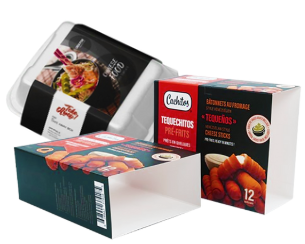business-services

April 05,2025 • 5 min read
A Guide To Designing Food Sleeve Packaging

Creating a strong first impression is crucial in the food industry, and Food Sleeve Packaging plays an essential role in shaping how customers perceive your product. Whether you're a boutique patisserie or a high-volume supplier, packaging must strike a balance between style and substance. Food Sleeve Packaging not only attracts attention but also contributes to sustainability, making it a popular tool for visual storytelling. This guide walks you through vital techniques and thoughtful approaches to make your sleeve designs stand out on the shelf. From material selection to layout execution, every element contributes to how the consumer connects with your brand. Let’s uncover how you can turn packaging into a product’s strongest marketing tool.
Fundamentals of Effective Food Sleeve Packaging
Balance is the foundation of exceptional design when it comes to Food Sleeve Packaging. While style might draw a buyer’s eye, structure guarantees functionality. Sleeves should grip the product securely but still allow for easy removal without damaging its contents. A high-quality sleeve serves both the practical and aesthetic roles effectively.
Clarity in communication is equally critical. Consumers rely on packaging to relay essential details—like ingredients, expiry dates, and allergen information—without confusion. Moreover, material choices also influence brand perception. As environmental concerns grow, using compostable or recycled sleeves strengthens your ethical identity. Ultimately, good packaging blends visuals, transparency, and efficiency into one seamless layer.
Design Principles That Attract and Engage
Creativity drives engagement, especially in a crowded marketplace. Applying balanced layouts, symmetrical designs, and complementary colors can shift consumer behavior toward your product. Additionally, finishes like matte textures or metallic foils can offer a sensory touchpoint that builds interest.
Fonts matter just as much as imagery. A clean typeface communicates trust and quality, while handwritten styles evoke warmth and tradition. Integrating spacing and alignment properly keeps the design legible. Similarly, graphics should support—not overshadow—the main message. Because details count, choosing premium materials can reinforce the value of your offering.
Innovative Features That Add Value
Innovation in sleeves often means simplifying user interaction without sacrificing appeal. Here are some smart features you can incorporate:
-
Transparent cut-outs that display the actual product
-
Embossed icons or textures that create tactile feedback
-
Scannable codes that offer nutrition info or recipes
-
Heat-sealed finishes that improve hygiene
Functionality works best when it's subtle but intuitive. Each feature must serve a purpose while increasing overall presentation and usability.
“Good packaging is a marketing tool in itself.”
Packaging as a Branding Statement
Distinct packaging transforms a simple product into a memorable experience. A sleeve should clearly reflect what your product stands for, whether it's freshness, indulgence, or innovation. Good branding ensures that the package tells the story even when there’s no one explaining it.
Color theory can support your message in powerful ways. Earthy tones hint at natural ingredients, while vibrant hues suggest excitement or fun. Though fonts and logos play their part, consistency across design elements ensures coherence. As packaging is often the first point of contact with customers, creating an emotional appeal through storytelling design increases loyalty over time.
Key Guidelines for Sleeve Development
Framework and accuracy keep the packaging process error-free. Follow these numbered guidelines for smooth execution:
-
Understand your audience’s preferences, lifestyle, and buying habits.
-
Measure your product precisely before finalizing sleeve dimensions.
-
Preview mockups to test both usability and visual appeal.
-
Align your material and ink selection with intended printing methods.
Precision at every level avoids production waste and preserves brand image. Compliance with food-labeling laws must also be maintained to avoid legal setbacks. Furthermore, attention to proportions helps ensure the final result looks professional on all types of shelves.
Trends Shaping the Future of Packaging
Globally, demand for sustainable and minimalist designs continues to grow. Biodegradable sleeves—especially those made from kraft paper or bamboo fibers—are gaining preference due to their low environmental impact.
Customizable modular templates are another trend, making it easier to adjust packaging across various product lines. Furthermore, the shift toward water-based coatings and vegetable inks supports greener practices. Although digital printing is expanding, large-scale operations still rely on offset methods for efficiency. Staying current with these trends helps businesses remain relevant and responsible at the same time.
Materials and Their Sustainable Roles
Natural alternatives are reshaping how packaging is approached. Recyclable or compostable sleeves communicate your brand's commitment to the environment. Options like sugarcane pulp and recycled cardboard offer durability without waste. Soy-based coatings are now replacing glossy lamination, reducing chemical impact while maintaining finish quality.
Corrugated sleeves reduce shipping bulk and emissions. Yet, they don’t compromise on durability, making them ideal for both local and global distribution. Since transparency in sourcing builds customer trust, many UK Packaging Companies now provide material traceability and eco-certification to help brands align with market demand.
Conclusion
Smart design through Food Sleeve Packaging speaks louder than words. Each curve, texture, and print carries a message about the product and the brand behind it. Through deliberate decisions in material, structure, and tone, packaging evolves into a silent ambassador. As UK Packaging Companies introduce cleaner, more innovative solutions, brands have the opportunity to connect deeper with their customers. One sleeve can be the difference between getting noticed and being ignored so let every fold and color count toward something meaningful.
Anna Devil Details
User Profile
- Full name
- Anna Devil
- Email address
- bellajohn.za32@gmail.com
- Join Date
- 2025-04-05
- State
- City
- Pincode
- Address
- Follow us on Facebook
- Follow us on Twitter
- Website Name
- Bio